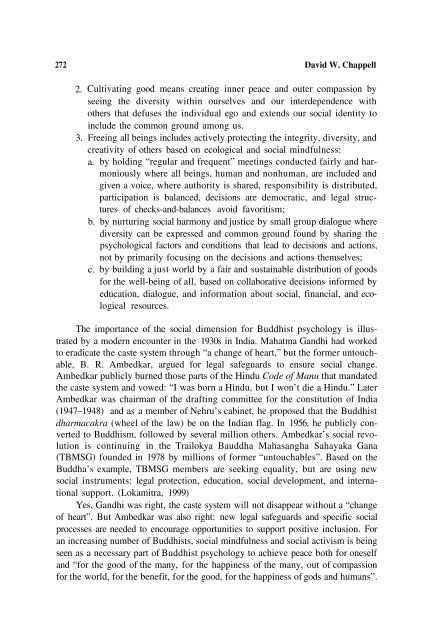Psychology & Buddhism.pdf
Psychology & Buddhism.pdf
Psychology & Buddhism.pdf
Create successful ePaper yourself
Turn your PDF publications into a flip-book with our unique Google optimized e-Paper software.
272 David W. Chappell<br />
2.<br />
3.<br />
Cultivating good means creating inner peace and outer compassion by<br />
seeing the diversity within ourselves and our interdependence with<br />
others that defuses the individual ego and extends our social identity to<br />
include the common ground among us.<br />
Freeing all beings includes actively protecting the integrity, diversity, and<br />
creativity of others based on ecological and social mindfulness:<br />
a. by holding “regular and frequent” meetings conducted fairly and harmoniously<br />
where all beings, human and nonhuman, are included and<br />
given a voice, where authority is shared, responsibility is distributed,<br />
participation is balanced, decisions are democratic, and legal structures<br />
of checks-and-balances avoid favoritism;<br />
b. by nurturing social harmony and justice by small group dialogue where<br />
diversity can be expressed and common ground found by sharing the<br />
psychological factors and conditions that lead to decisions and actions,<br />
not by primarily focusing on the decisions and actions themselves;<br />
c. by building a just world by a fair and sustainable distribution of goods<br />
for the well-being of all, based on collaborative decisions informed by<br />
education, dialogue, and information about social, financial, and ecological<br />
resources.<br />
The importance of the social dimension for Buddhist psychology is illustrated<br />
by a modern encounter in the 1930s in India. Mahatma Gandhi had worked<br />
to eradicate the caste system through “a change of heart,” but the former untouchable,<br />
B. R. Ambedkar, argued for legal safeguards to ensure social change.<br />
Ambedkar publicly burned those parts of the Hindu Code of Manu that mandated<br />
the caste system and vowed: “I was born a Hindu, but I won’t die a Hindu.” Later<br />
Ambedkar was chairman of the drafting committee for the constitution of India<br />
(1947–1948) and as a member of Nehru’s cabinet, he proposed that the Buddhist<br />
dharmacakra (wheel of the law) be on the Indian flag. In 1956, he publicly converted<br />
to <strong>Buddhism</strong>, followed by several million others. Ambedkar’s social revolution<br />
is continuing in the Trailokya Bauddha Mahasangha Sahayaka Gana<br />
(TBMSG) founded in 1978 by millions of former “untouchables”. Based on the<br />
Buddha’s example, TBMSG members are seeking equality, but are using new<br />
social instruments: legal protection, education, social development, and international<br />
support. (Lokamitra, 1999)<br />
Yes, Gandhi was right, the caste system will not disappear without a “change<br />
of heart”. But Ambedkar was also right: new legal safeguards and specific social<br />
processes are needed to encourage opportunities to support positive inclusion. For<br />
an increasing number of Buddhists, social mindfulness and social activism is being<br />
seen as a necessary part of Buddhist psychology to achieve peace both for oneself<br />
and “for the good of the many, for the happiness of the many, out of compassion<br />
for the world, for the benefit, for the good, for the happiness of gods and humans”.











